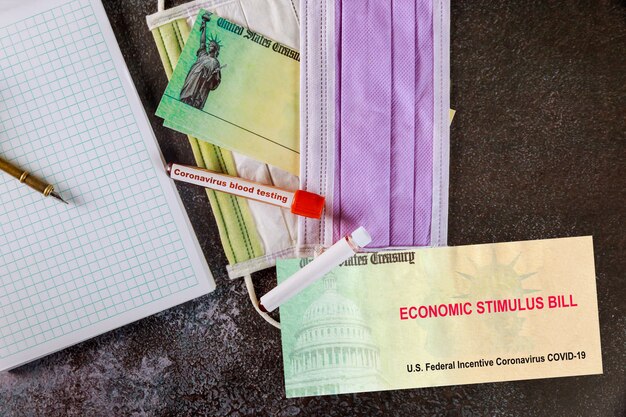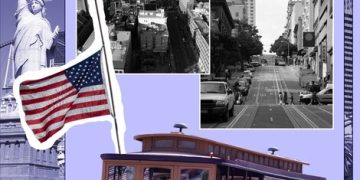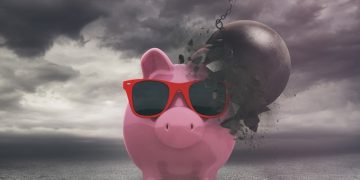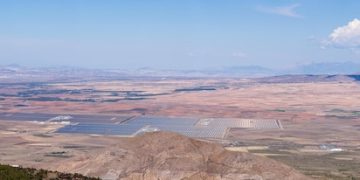Long-Term Economic Effects of COVID-19 on the US Economy

The long-term economic effects of the COVID-19 pandemic on the US include shifts in labor dynamics, accelerated technological adoption, increased government debt, altered consumer behavior, and potential disruptions in global supply chains, all contributing to reshaping the nation’s economic landscape.
The COVID-19 pandemic has left an indelible mark on the global economy, and the United States is no exception. Understanding what are the Long-Term Economic Effects of the COVID-19 Pandemic on the US? requires a thorough examination of various sectors and economic indicators.
Understanding the Initial Economic Shock
The onset of the COVID-19 pandemic in early 2020 triggered an unprecedented economic shock in the United States. Businesses shuttered, unemployment soared, and consumer spending plummeted as the nation grappled with the health crisis and associated lockdowns.
The immediate economic impact was widespread, affecting nearly every sector of the economy. Let’s delve into some key areas that experienced profound initial shocks:
Labor Market Turmoil
The labor market bore the brunt of the initial economic shock, with millions of Americans losing their jobs almost overnight. Industries such as hospitality, travel, and retail experienced massive layoffs as demand evaporated.
Supply Chain Disruptions
Global supply chains were severely disrupted as factories closed and transportation networks were hampered. This led to shortages of essential goods and materials, further exacerbating the economic downturn.
- Reduced industrial output due to factory shutdowns in key manufacturing hubs.
- Delays in transportation and shipping, leading to increased costs and longer lead times.
- Shortages of critical components and raw materials, impacting production across various industries.
In conclusion, the initial economic shock of the COVID-19 pandemic was severe and far-reaching, impacting the labor market, supply chains, and various sectors of the economy. Understanding these immediate effects is crucial for assessing the long-term consequences and developing effective strategies for recovery.

Shifts in Labor Dynamics
The pandemic accelerated shifts in labor dynamics. Remote work became more prevalent, prompting companies to re-evaluate their office space needs and invest in technology to support distributed teams.
We will now explore how these shifts in labor dynamics can have lasting effects on the US economy:
The Rise of Remote Work
Remote work has emerged as a permanent feature of the modern workplace, offering employees greater flexibility and autonomy. Companies that embrace remote work can tap into a wider talent pool and reduce overhead costs.
The Great Resignation
The pandemic prompted many workers to re-evaluate their priorities, leading to a phenomenon known as the “Great Resignation.” Millions of Americans voluntarily left their jobs in search of better opportunities, higher pay, and improved work-life balance.
- Increased competition among companies to attract and retain talent.
- Greater emphasis on employee well-being and work-life balance.
- A shift in power dynamics from employers to employees.
In summary, the pandemic-induced shifts in labor dynamics have profound implications for the US economy. The rise of remote work, the Great Resignation, and the changing nature of employment relationships are reshaping the labor market in fundamental ways.
Accelerated Technological Adoption
The pandemic forced businesses to rapidly adopt new technologies to maintain operations and serve customers remotely. E-commerce, telemedicine, and online education experienced significant growth as consumers and businesses adapted to the new normal.
Here are some ways that accelerated technological adoption can shape the US economy in the long run:
E-Commerce Boom
The pandemic accelerated the shift from brick-and-mortar retail to online shopping, with e-commerce sales reaching record levels. This trend is likely to persist, as consumers have become accustomed to the convenience and variety offered by online retailers.
Telemedicine Expansion
Telemedicine emerged as a critical tool for delivering healthcare services during the pandemic, allowing patients to consult with doctors remotely and avoid crowded waiting rooms. Telemedicine is poised to play an increasingly important role in the healthcare system.
- Improved access to healthcare services for rural and underserved populations.
- Reduced healthcare costs through virtual consultations and remote monitoring.
- Greater convenience and flexibility for patients and providers.
In conclusion, the pandemic-driven acceleration of technological adoption has far-reaching implications for the US economy. The e-commerce boom, the expansion of telemedicine, and the digital transformation of industries are reshaping the economic landscape. This technological advancements have the potential to drive innovation, boost productivity, and enhance the competitiveness of the US economy.

Increased Government Debt
In response to the economic crisis, the US government implemented massive fiscal stimulus measures, including direct payments to individuals, expanded unemployment benefits, and loans to businesses. While these measures provided much-needed relief, they also led to a significant increase in government debt.
Let’s explore the potential long-term economic effects of increased government debt in the US:
Impact on Interest Rates
Higher government debt levels can put upward pressure on interest rates, as investors demand a higher return to compensate for the increased risk of lending to the government. Rising interest rates can increase borrowing costs for businesses and consumers, potentially dampening economic growth.
Inflationary Pressures
Some economists argue that large-scale fiscal stimulus can lead to inflation, as increased government spending boosts demand without a corresponding increase in supply. Inflation can erode purchasing power and create economic instability.
- A potential decline in the value of the US dollar.
- Reduced international competitiveness as US goods and services become more expensive.
- Increased uncertainty and volatility in financial markets.
In summary, the increased government debt incurred during the COVID-19 pandemic poses significant challenges for the US economy. Managing this debt burden will require careful fiscal planning and responsible economic policies to avoid adverse consequences such as rising interest rates and inflationary pressures.
Altered Consumer Behavior
The pandemic has profoundly altered consumer behavior, with lasting effects on spending habits, preferences, and priorities. Consumers have become more cautious and value-conscious, prioritizing essential goods and services over discretionary spending.
We will now examine some of the key ways consumer behavior has changed and the potential implications for the US economy:
Shift to Online Spending
As previously noted, the pandemic accelerated the shift to online spending, with consumers embracing e-commerce as a convenient and safe way to shop. This trend is likely to persist, as consumers have become accustomed to the ease and variety offered by online retailers.
Increased Savings Rate
Uncertainty about the future prompted many consumers to increase their savings rate, reducing discretionary spending. While increased savings can provide a cushion during economic downturns, it can also dampen economic growth by reducing demand.
- A decline in spending on travel, entertainment, and dining out.
- Increased demand for home improvement and renovation projects.
- A growing emphasis on health, wellness, and personal care products.
In conclusion, the altered consumer behavior resulting from the COVID-19 pandemic has significant implications for the US economy. Understanding these shifting preferences and spending habits is crucial for businesses as they adapt their strategies to meet the changing needs of consumers.
Potential Disruptions in Global Supply Chains
The pandemic exposed vulnerabilities in global supply chains, highlighting the risks of relying on single sources of supply and just-in-time inventory management. Disruptions in global supply chains can lead to shortages of essential goods and materials, impacting production and driving up prices.
These potential further disruptions in the supply chain, could have impacts such as the following on the US economy:
Geopolitical Tensions
Geopolitical tensions and trade disputes can disrupt global supply chains, as countries impose tariffs and restrictions on trade. These disruptions can increase costs and reduce the availability of goods and materials.
Cybersecurity Risks
Global supply chains are increasingly vulnerable to cyberattacks, which can disrupt operations and compromise sensitive data. Cybersecurity risks are a growing concern for businesses and governments alike.
- Diversifying sources of supply to reduce reliance on single suppliers.
- Building resilience into supply chains to withstand disruptions.
- Investing in cybersecurity to protect against cyberattacks.
In summary, the potential disruptions in global supply chains pose significant risks to the US economy. Addressing these vulnerabilities will require a proactive and multifaceted approach, including diversifying sources of supply, building resilience into supply chains, and investing in cybersecurity.
| Key Aspect | Brief Description |
|---|---|
| 💸 Increased Debt | Governments had to borrow heavily to fund stimulus and support programs. |
| 💻 Tech Adoption | Businesses accelerated the use of digital tools, impacting job skills needed. |
| 💼 Labor Shifts | Rise in remote work and changes in workforce participation rates. |
| 🛒 Consumer Behavior | Changes in consumer habits, savings rates, and spending patterns. |
Frequently Asked Questions
▼
Stimulus checks aimed to boost consumption, providing immediate relief to households. While they supported spending, they also contributed to inflation and increased national debt.
▼
The “Great Resignation” refers to a significant number of workers leaving jobs, seeking better opportunities or work-life balance. This has led to labor shortages and wage increases.
▼
The rise of remote work has reduced demand for office space, leading to higher vacancy rates and potential devaluation of commercial real estate in urban areas.
▼
Supply chain disruptions have led to increased costs and delays. Companies are now diversifying supply chains to enhance resilience and reduce dependence on single sources.
▼
Persistent high inflation can erode purchasing power, increase business costs, and necessitate tighter monetary policies, potentially slowing economic growth and recovery efforts.
Conclusion
In conclusion, the COVID-19 pandemic has had multifaceted and enduring economic effects on the United States. These range from immediate shocks to long-term shifts in labor, technology, consumer behavior, and governmental roles, reshaping the economic landscape for years to come, requiring continuous monitoring and adaptive strategies.





